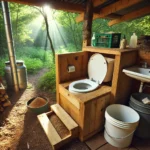Starting your journey toward building an off-grid homestead is both exciting and empowering! Whether you’re looking for self-sufficiency, a simpler lifestyle, or just a place to call your own away from the hustle and bustle, creating an off-grid haven is achievable with the right planning and determination. Let’s dive into the steps to find your dream property and transform it into a thriving homestead.
What Is an Off-Grid Homestead?
An off-grid homestead is a self-sufficient property disconnected from public utilities like water, electricity, and sewage. This doesn’t mean you’re living without modern comforts—it means you’re generating them independently. Solar panels, rainwater collection systems, and compost toilets are just a few tools to make it possible.
For preppers and self-reliant folks, an off-grid homestead isn’t just a dream; it’s a way to live securely and sustainably.
Step 1: Finding the Perfect Location
The first step in creating an off-grid homestead is finding the right land. Here’s what to consider:
1. Zoning and Regulations:
Before purchasing, check local laws to ensure off-grid living is allowed. Some areas restrict composting toilets, solar setups, or building off-grid entirely.
2. Accessibility and Isolation:
Do you want total seclusion or a property within reasonable distance of towns for supplies? Choose a balance that fits your lifestyle.
3. Natural Resources:
Look for land with abundant sunlight, water sources, and fertile soil. These are the foundations of off-grid success.
4. Size and Terrain:
A few acres can be enough, but if you plan to grow crops or raise animals, you’ll need more space. Flat land makes construction easier, while hills can provide natural windbreaks or water runoff points.
Step 2: Planning Your Homestead
Once you’ve secured the land, it’s time to design your off-grid oasis!
1. Water Supply:
Install a well, rainwater collection system, or find a natural water source. Water is essential not just for drinking but for gardening and livestock.
2. Power Generation:
Solar panels are a popular choice, but you might also consider wind turbines or micro-hydro systems depending on your location.
3. Waste Management:
Compost toilets, septic systems, or greywater recycling are all viable off-grid options. Choose a system that suits your property and lifestyle.
4. Shelter:
Decide if you’ll build from scratch, renovate an existing structure, or use alternative options like tiny homes, yurts, or even shipping containers.
Step 3: Building Your Off-Grid Homestead
With a plan in place, it’s time to roll up your sleeves and start building!
1. Construct Your Shelter:
Begin with a sturdy, weatherproof shelter. Prioritize insulation and energy efficiency to reduce your heating and cooling needs.
2. Set Up Utilities:
- Electricity: Install solar panels or other systems to power your home.
- Water: Build storage tanks or connect your rainwater collection system.
- Waste: Finalize your compost toilet or other waste management system.
3. Grow Your Own Food:
Homesteading isn’t complete without a garden! Start small with raised beds or container gardens and expand as you learn. Chickens, goats, or bees can provide eggs, milk, and honey, while also enriching your homestead ecosystem.
Overcoming Challenges
Building an off-grid homestead has its challenges, but they’re all part of the adventure!
- Initial Costs: Off-grid systems like solar panels and wells require upfront investment but save money long-term.
- Maintenance: Solar batteries, water filters, and other equipment need regular care. Learn basic repair skills to stay self-reliant.
- Isolation: If you’re far from towns, plan for emergencies by keeping a well-stocked supply of essentials and medical items.
Tips for Long-Term Success
- Learn Continuously: Read books, join forums, and connect with other homesteaders to share knowledge and tips.
- Start Simple: Begin with essentials like shelter and water before expanding into livestock or large gardens.
- Stay Flexible: Adapt your plans as you learn what works best for your land and lifestyle.
Why an Off-Grid Homestead Is Worth It
Living on an off-grid homestead offers unmatched freedom and peace of mind. You’re no longer tied to utility bills or urban chaos. Instead, you gain control over your resources, your time, and your future. Whether you’re growing your own food, generating your own power, or enjoying the beauty of nature, every moment is a step toward a fulfilling, sustainable life.



